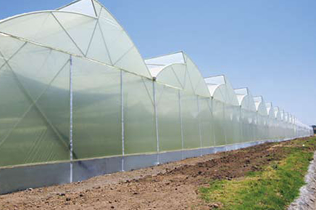By John W. Bartok Jr.
The trend toward natural ventilation can eliminate the need for fans. If you have attended any of the industry product shows recently, you have seen new technology that will be part of your operation soon. There are many exciting developments that will make your job easier, reduce labor input and produce better plants.
Here are a few trends that I think will have an impact on your operations:
Internet information – The use of the internet is increasing rapidly. Information on what products are available, how to select the right one and how to install and maintain them is becoming readily available on the web. Purchasing through the internet will continue to increase. Monitoring and controlling the greenhouse environment with internetcontrolled electronic devices is becoming standard practice.
 Greenhouse design – To reduce electricity costs, more greenhouses are being built or retrofitted with natural ventilation. To increase the effectiveness of natural ventilation, greenhouses are getting taller. This also allows room for multiple energy/shade screens and more space for hanging basket production.
Greenhouse design – To reduce electricity costs, more greenhouses are being built or retrofitted with natural ventilation. To increase the effectiveness of natural ventilation, greenhouses are getting taller. This also allows room for multiple energy/shade screens and more space for hanging basket production.
Natural gas and high-efficiency heaters reduce heating cost. With improvements and lower prices for photovoltaic systems, growers are installing systems to offset the increasing cost of electricity. Several research projects are currently investigating the incorporation of solar collectors into the glazing on the greenhouse.
Supplemental lighting – There is a strong trend to install more efficient LED and HID lighting. Several research projects are looking at the benefits and economics of better plant growth control and greater utilization of greenhouses during the winter.
Irrigation – Water is become a regulated resource in many areas. There have been many innovations and improvements in the way water is applied to grow plants. Recycling, improved application methods, new sensors and controllers are available. These need to be put into use by growers, both large and small.
Environment controls – Great strides have been made over the past few years in integrating the equipment that controls the greenhouse environment. Both controllers and computers are readily available today. A trend toward using electronic controls by the smaller grower is developing. Besides saving energy, better plant quality and a shorter growing season can result.
Mechanization – Labor input for many crops is being reduced with new equipment. A trend toward once-through production is starting to develop. Equipment for spacing plants and plug sticking are the latest equipment developments. With labor being the greatest cost in the production of most plants and availability limited in many sections of the country, greenhouse operations will be designed to be more labor-efficient, utilizing mechanization.
Management – With the increase in mechanization and controls, there will be a greater need for people trained to select and maintain this technology. Engineers and technical service personnel will become part of many larger operations. Consultants are now available from suppliers to help growers.
There are still many challenges and opportunities in the greenhouse industry. Based on technology changes that have taken place in the last 50 years, it may be difficult to recognize the way greenhouse operations will look in the next 50 years. If a business is to succeed, it will have to select and install the technology that best fits these trends.
John is an agricultural engineer, an emeritus extension professor at the University of Connecticut and a regular contributor to Greenhouse Management. He is an author, consultant and certified technical service provider doing greenhouse energy audits for USDA grant programs in New England. This email address is being protected from spambots. You need JavaScript enabled to view it.


